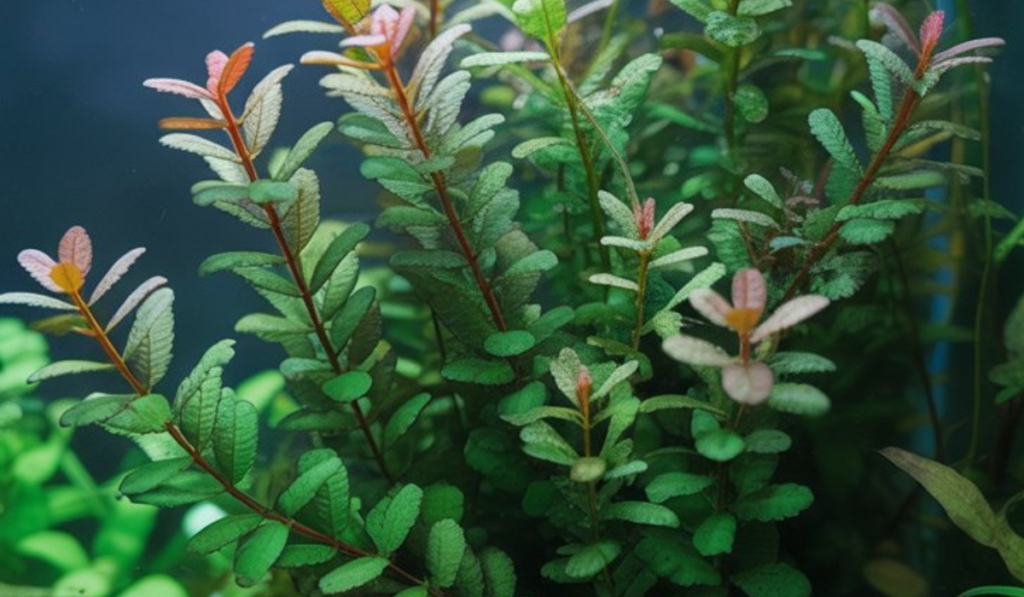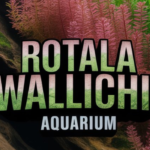Aquatic plants are the backbone of any thriving freshwater aquarium, bringing natural beauty, oxygenation, and balance to the tank environment. Among the wide variety of stem plants, Rotala rotundifolia is one of the most popular and versatile species for aquascaping. Its delicate leaves, lush growth, and ability to display stunning red hues under the right conditions make it a favorite among both beginners and expert aquarists.
In this comprehensive guide, we’ll explore everything you need to know about keeping Rotala rotundifolia in an aquarium—from identification and benefits to ideal tank conditions, care, aquascaping tips, propagation, and troubleshooting common issues. By the end, you’ll be ready to use this plant to transform your tank into a vibrant underwater landscape.
What is Rotala Rotundifolia?
Rotala rotundifolia is a fast-growing aquatic stem plant native to Southeast Asia, particularly India, China, and Vietnam. The name “rotundifolia” means “round leaves,” referring to the plant’s submerged juvenile form that initially produces small round leaves. As the plant matures underwater, its leaves transform into slender, elongated shapes, often displaying shades of green, orange, or red depending on the conditions.
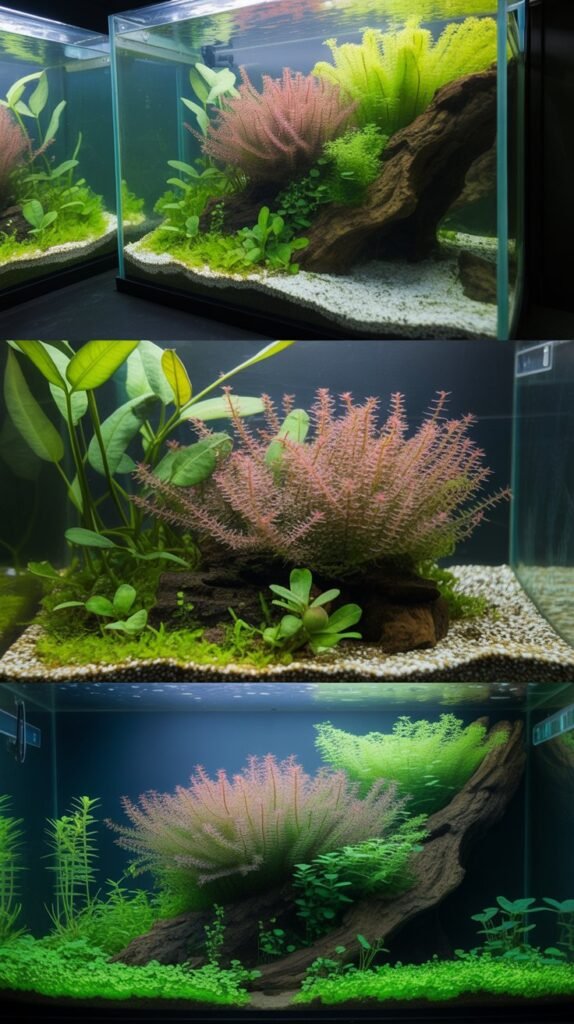
This plant is prized for its adaptability—it can thrive in low-tech aquariums with minimal care, but under high lighting and CO₂ injection, it develops vibrant red hues that make it a centerpiece in aquascaping designs.
Why Choose Rotala Rotundifolia for Your Aquarium?
Aquarists love Rotala rotundifolia for several reasons:
1. Stunning Colors
- Produces green leaves in low light.
- Turns orange to red under strong lighting and proper nutrients.
2. Fast Growth
- Helps absorb excess nutrients and suppress algae growth.
- Quickly fills background spaces with lush greenery.
3. Versatility in Aquascaping
- Can be used as a background plant, midground accent, or even trimmed into compact bushes.
- Provides texture and depth in aquascapes.
4. Easy Propagation
- Propagates through simple cuttings.
- New plants sprout roots quickly, making it beginner-friendly.
5. Fish and Shrimp Friendly
- Offers shelter for fry and shrimp.
- Creates a natural environment for small fish to explore.
Ideal Aquarium Conditions for Rotala Rotundifolia
Although Rotala rotundifolia is relatively hardy, giving it the right environment allows it to thrive and show its best colors.
1. Tank Size
- Works well in tanks as small as 10 gallons.
- Best suited for medium to large aquariums where it can grow tall and bushy.
2. Lighting
- Low to medium light: Green leaves dominate.
- High light: Leaves turn pink, orange, or deep red.
- Consistent lighting (8–10 hours/day) ensures steady growth.
3. Substrate
- Prefers nutrient-rich substrates such as aqua soil.
- Can grow in inert gravel or sand with supplementation via root tabs and liquid fertilizers.
4. Water Parameters
- Temperature: 68°F – 82°F (20°C – 28°C)
- pH: 6.0 – 7.5
- Hardness: Soft to moderately hard water
5. CO₂ Injection
- Not required for basic growth.
- Strongly recommended for red coloration and faster, denser growth.
6. Fertilization
- Requires regular supplementation of macro nutrients (NPK) and micronutrients (iron, magnesium).
- Iron is particularly important for enhancing red tones.
How to Plant Rotala Rotundifolia in an Aquarium
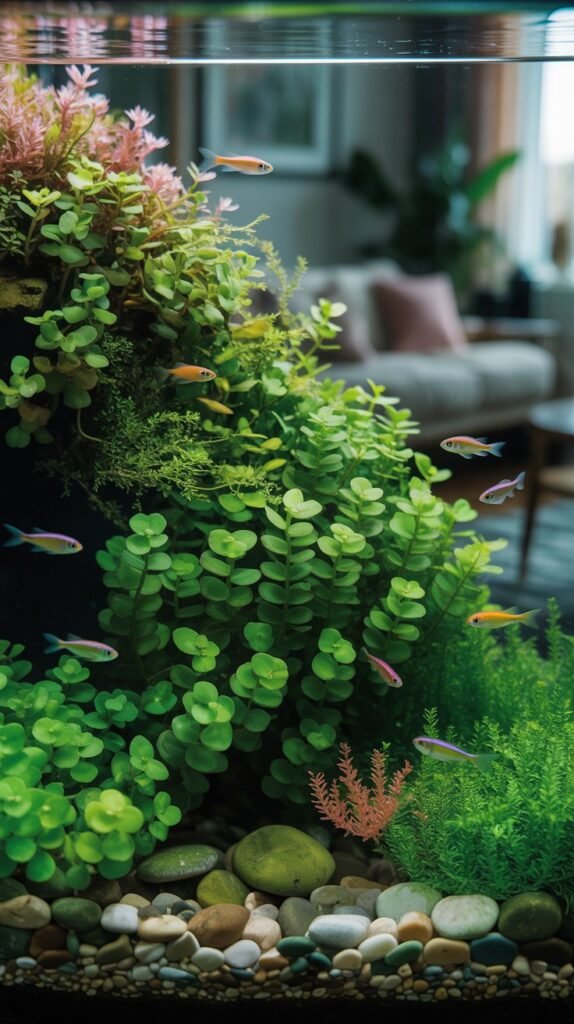
Planting Rotala rotundifolia correctly ensures that it establishes quickly and grows healthily.
Step 1: Preparation
- Trim off the bottom leaves to expose nodes.
- Cut stems into equal lengths for even planting.
Step 2: Planting
- Use aquascaping tweezers to insert stems into the substrate.
- Plant in small groups (5–10 stems per cluster) with space between to allow light penetration.
Step 3: Growth Management
- Once established, the plant will grow vertically toward the surface.
- Trim tops regularly and replant cuttings to create fuller bushes.
Rotala Rotundifolia in Aquascaping
Rotala rotundifolia is a favorite in aquascaping competitions due to its ability to create dramatic effects.
1. Background Plant
- Typically planted in the background where its tall stems can rise behind shorter plants.
2. Color Accents
- Red and orange shades create contrast against green plants like Anubias or Java Fern.
3. Bushy Midground Feature
- With frequent trimming, Rotala can be shaped into compact bushes for the midground.
4. Dutch-Style Aquascaping
- In Dutch aquascapes, Rotala rotundifolia is used for color blocks and geometric layouts.
5. Iwagumi Aquascaping
- Provides a soft, flowing texture behind stone hardscape arrangements.
Propagation of Rotala Rotundifolia
Rotala rotundifolia is one of the easiest aquarium plants to propagate.
How to Propagate:
- Trim the top 4–6 inches of a healthy stem.
- Remove lower leaves to expose nodes.
- Replant the cutting in the substrate.
- The original stem will produce side shoots, making the cluster bushier.
This propagation cycle allows aquarists to quickly fill large areas of their aquarium with minimal effort.
Common Problems with Rotala Rotundifolia
Even though this plant is hardy, some issues may arise:
1. Leaves Turning Pale or Yellow
- Cause: Nutrient deficiency, especially nitrogen or iron.
- Solution: Supplement with liquid fertilizers.
2. Leggy Growth (Sparse Leaves)
- Cause: Insufficient lighting.
- Solution: Increase light intensity and ensure stems are not overcrowded.
3. Failure to Turn Red
- Cause: Low light, lack of CO₂, or poor nutrients.
- Solution: Provide stronger lighting, add CO₂, and dose iron-rich fertilizers.
4. Melting After Planting
- Cause: Stress from transition between emersed and submerged growth.
- Solution: Trim melted leaves and allow new submerged growth to develop.
5. Algae Growth
- Cause: Excess light or nutrient imbalance.
- Solution: Maintain proper balance, add algae-eating fish or shrimp.
Tank Mates for Rotala Rotundifolia
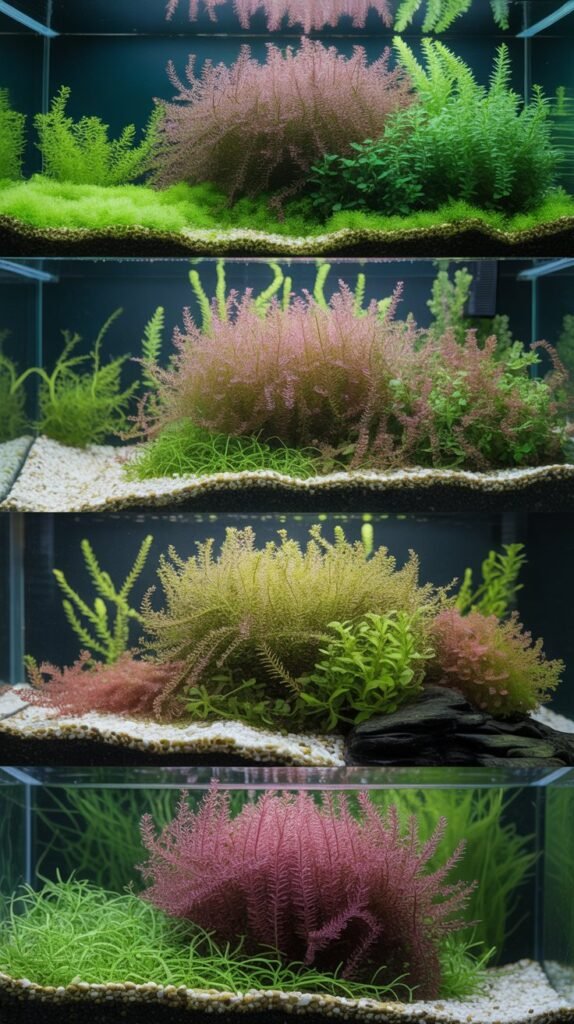
Rotala rotundifolia is compatible with most community tank species.
Best Tank Mates:
- Tetras, Rasboras, and Gouramis
- Bettas (if kept in a planted setup)
- Guppies, Mollies, and other livebearers
- Shrimp and snails
Avoid:
- Goldfish (will eat and uproot plants)
- Large cichlids (tend to dig and damage roots)
Rotala Rotundifolia Varieties
There are several variations of Rotala rotundifolia, each with unique characteristics:
- Rotala rotundifolia ‘Green’ – Remains green even under high light.
- Rotala rotundifolia ‘Red’ – Turns bright red under intense light and CO₂.
- Rotala rotundifolia ‘Colorata’ – Displays pink to orange hues.
- Rotala rotundifolia ‘H’ra’ – Narrow leaves with intense red coloration.
- Rotala rotundifolia ‘Blood Red’ – Vibrant deep red leaves, demanding in care.
These varieties allow aquarists to experiment with different color tones and aquascaping effects.
Rotala Rotundifolia vs Other Rotala Species
| Feature | Rotala Rotundifolia | Rotala Wallichii | Rotala Indica |
|---|---|---|---|
| Ease of Care | Easy to Moderate | Difficult (high demands) | Moderate |
| Color Range | Green to red/orange | Pink to red (fine needle-like) | Green to pink |
| Growth Speed | Fast | Moderate | Moderate |
| Best Use in Aquascape | Background or bushy midground | Background accent | Background |
Step-by-Step Guide: Setting Up a Rotala Rotundifolia Aquarium
- Choose Tank Size – Minimum 10 gallons for stable growth.
- Prepare Substrate – Use nutrient-rich soil or supplement inert gravel with root tabs.
- Install Lighting – Provide medium to high-intensity LED lights.
- Add CO₂ (Optional but Recommended) – Enhances color and growth.
- Plant in Clusters – Space stems for light penetration.
- Supplement Nutrients – Dose iron-rich fertilizers regularly.
- Trim and Propagate – Shape bushes and prevent overgrowth.
- Balance Layout – Mix with green, broad-leaved plants for contrast.
Tips for Thriving Rotala Rotundifolia
- Trim often to maintain bushy, compact clusters.
- Use floating rings to prevent overcrowding at the surface.
- Combine with slow-growing plants (Anubias, Cryptocoryne) for a balanced aquascape.
- Keep nitrates stable at 10–20 ppm for healthy coloration.
- Avoid sudden water parameter changes to prevent melting.
Conclusion
The Rotala rotundifolia aquarium plant is a stunning, fast-growing stem plant that adds beauty, depth, and functionality to freshwater aquariums. With its ability to transition from green to shades of pink, orange, and red, it offers aquarists unmatched versatility in aquascaping.
Whether you’re new to planted tanks or an advanced aquascaper, Rotala rotundifolia is a must-have species that can transform your aquarium into a lush underwater forest. With the right lighting, nutrients, and trimming routine, this plant will reward you with vibrant growth and breathtaking color displays.
FAQs About Rotala Rotundifolia Aquarium
Q1: Is Rotala rotundifolia beginner-friendly?
Yes, it is one of the most beginner-friendly stem plants, growing well even without CO₂.
Q2: Why is my Rotala rotundifolia not turning red?
Low lighting, lack of CO₂, or nutrient deficiencies (especially iron) can prevent red coloration.
Q3: Can Rotala rotundifolia grow without CO₂?
Yes, it can, but it will mostly stay green and grow slower compared to CO₂-enriched setups.
Q4: How often should I trim Rotala rotundifolia?
Trim every 2–3 weeks or when it reaches the surface, to encourage bushier side shoots.
Q5: Can I use Rotala rotundifolia in low-tech aquariums?
Absolutely! It adapts well but may not show its full red coloration.
Q6: Is Rotala rotundifolia safe for shrimp tanks?
Yes, shrimp thrive around its stems, feeding on biofilm.
Q7: What is the difference between Rotala rotundifolia and Rotala indica?
Rotala indica is less commonly used and has different leaf shapes, while Rotala rotundifolia is more colorful and versatile.
Q8: How do I propagate Rotala rotundifolia?
Simply cut healthy stem tops and replant them into the substrate.
Q9: Can Rotala rotundifolia be grown floating?
Yes, it can survive floating, but planting in substrate gives better results.
Q10: Which Rotala rotundifolia variety is best for red color?
Rotala rotundifolia ‘H’ra’ and ‘Blood Red’ are the best choices for deep red hues under high light and CO₂.

